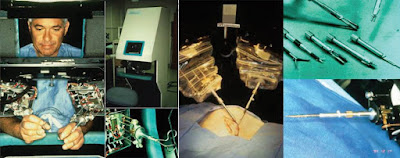Surgical robotics archive vol.9.
Following a series of successful articles about the early days of surgical robotics (Vol.1, Vol.2, Vol.3,
Vol.4, Vol.5, Vol.6, Vol.7, Vol.8), here is another story:
Source: JSLS
In a recent article "Origins of Robotic Surgery: From Skepticism to Standard of Care", pioneers of the domain described some very early work in surgical robotics. Some vintage figures:
The telepresence surgeon’s workstation (TSW) and a remote surgical unit (RSU) at SRI, built in 1994-95.
"In 1987, Joseph Rosen left Stanford for a faculty position at Dartmouth Medical Center, and US Army Colonel (COL) Richard Satava, MD, joined the team as SRI began construction of the first prototype of a robotic surgery system, which Dr. Green called the “telepresence surgery system.” They created a workstation that used handles from actual surgical instruments in the place of gloves, as well as an advantageously stereoscopic monitor rather than the HMD.
The first manipulators used by SRI were patented in 1995 and continued by Dr. Green in 1998.14 One of the most notable differences between SRI’s system and the systems available today was SRI’s inclusion of haptic feedback. The Green Telepresence System’s manipulators held force-sensing elements on the distal portion of the mechanism that could sense lateral forces and transmit the sensations to the surgeon’s controllers.
Early versions of the manipulators were limited to 4 degrees of freedom (DOFs), allowing the surgeon to have translational movement in 3 dimensions as well as axial rotation.
The system was originally conceived for open surgery, but when COL Satava observed the presentation of Dr. Jacques Perrisat’s videotaped laparoscopic cholecystectomy at the Society of American Gastrointestinal and Endoscopic Surgeons (SAGES) conference in 1989, he urged the SRI team to transition the telepresence system toward laparoscopic surgery.9 COL Satava argued that the telepresence system offered a solution through the use of robotic instrumentation that solved the problem of the fulcrum effect of traditional laparoscopic tools.16 In addition, it provided a full high-definition stereoscopic vision, enhanced dexterity, tremor reduction, and motion scaling that could improve a surgeon’s performance, even beyond human physical limitations."



Comments